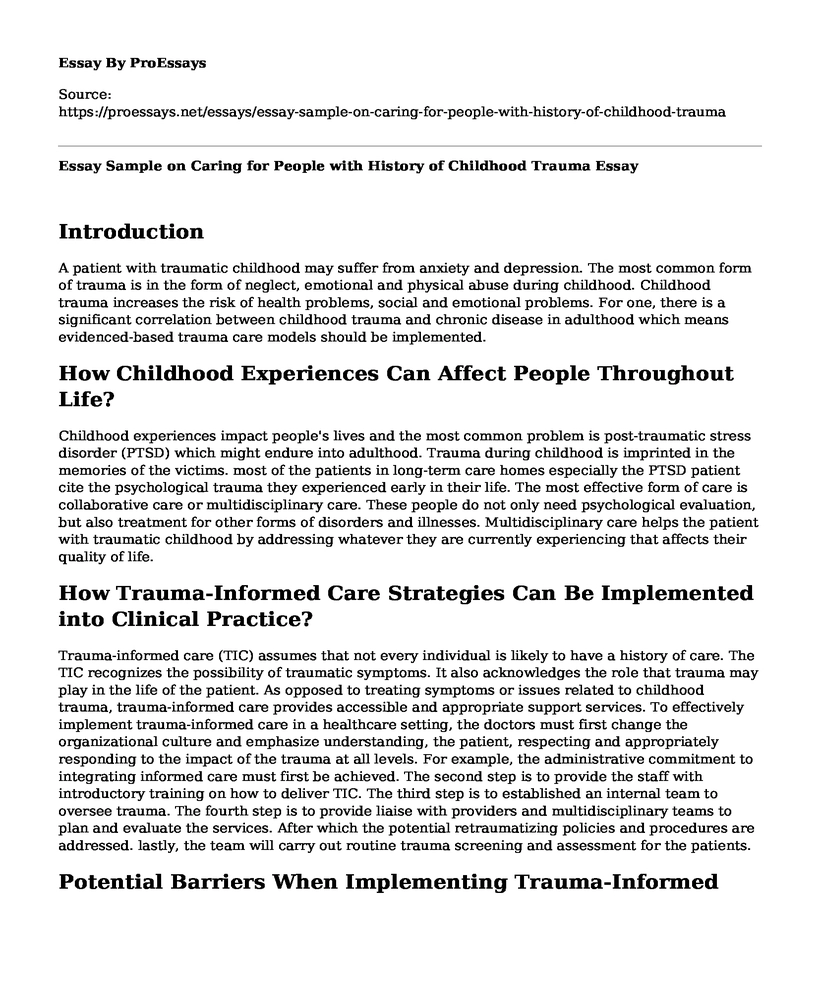Introduction
A patient with traumatic childhood may suffer from anxiety and depression. The most common form of trauma is in the form of neglect, emotional and physical abuse during childhood. Childhood trauma increases the risk of health problems, social and emotional problems. For one, there is a significant correlation between childhood trauma and chronic disease in adulthood which means evidenced-based trauma care models should be implemented.
How Childhood Experiences Can Affect People Throughout Life?
Childhood experiences impact people's lives and the most common problem is post-traumatic stress disorder (PTSD) which might endure into adulthood. Trauma during childhood is imprinted in the memories of the victims. most of the patients in long-term care homes especially the PTSD patient cite the psychological trauma they experienced early in their life. The most effective form of care is collaborative care or multidisciplinary care. These people do not only need psychological evaluation, but also treatment for other forms of disorders and illnesses. Multidisciplinary care helps the patient with traumatic childhood by addressing whatever they are currently experiencing that affects their quality of life.
How Trauma-Informed Care Strategies Can Be Implemented into Clinical Practice?
Trauma-informed care (TIC) assumes that not every individual is likely to have a history of care. The TIC recognizes the possibility of traumatic symptoms. It also acknowledges the role that trauma may play in the life of the patient. As opposed to treating symptoms or issues related to childhood trauma, trauma-informed care provides accessible and appropriate support services. To effectively implement trauma-informed care in a healthcare setting, the doctors must first change the organizational culture and emphasize understanding, the patient, respecting and appropriately responding to the impact of the trauma at all levels. For example, the administrative commitment to integrating informed care must first be achieved. The second step is to provide the staff with introductory training on how to deliver TIC. The third step is to established an internal team to oversee trauma. The fourth step is to provide liaise with providers and multidisciplinary teams to plan and evaluate the services. After which the potential retraumatizing policies and procedures are addressed. lastly, the team will carry out routine trauma screening and assessment for the patients.
Potential Barriers When Implementing Trauma-Informed Care
Most barriers to implementing trauma-informed care are either organizational barriers or clinical barriers. The organizational barrier includes lack of support from the hospital management, lack of lead hips, and poor communication between the hospital staff about the transformation process. The third barrier of failure to engage the patient in organization planning. The fourth barrier is the lack of training clinical and non-clinical staff on how to implement TIC. The clinical barrier includes time constraints, fear of further retraumatizing the patients, and lack of dedicated space and support to provide psychosocial care.
Conclusion
Childhood trauma may impact the quality of life from childhood into adulthood. The survivors may experience feelings of anxiety, worry, shame, guilt, helplessness, hopelessness, grief, sadness, and anger. To treat these people, it is important to conduct the initial assessment to understand the nature of the past or childhood trauma to avoid retraumatizing the patient and disengaging him from the treatment. The initial assessment should be conducted in a structured way. The patient can easily tell their story in their own words if they are encouraged to respond in a short description
References
Hoysted, C., Babl, F., Kassam-Adams, N., Landolt, M., Jobson, L., & Van Der Westhuizen, C. et al. (2018). Knowledge and training in pediatric medical traumatic stress and trauma-informed care among emergency medical professionals in low- and middle-income countries. European Journal of Psychotraumatology, 9(1), 1468703. Doi: 10.1080/20008198.2018.1468703
Menschner, C., & Maul, A. (2016). Issue Brief: Key Ingredients for Successful Trauma-Informed Care Implementation. Hamilton, NJ: Center for Health Care Strategies. Retrieved from https://www.samhsa.gov/sites/default/files/programs_campaigns/childrens_mental_health/atc-whitepaper-040616.pdf
Cite this page
Essay Sample on Caring for People with History of Childhood Trauma. (2022, Mar 15). Retrieved from https://proessays.net/essays/essay-sample-on-caring-for-people-with-history-of-childhood-trauma
If you are the original author of this essay and no longer wish to have it published on the ProEssays website, please click below to request its removal:
- How Writing Can Be Used to Deepen Understanding - Essay Example
- Speech Analysis Essay on Oprah Winfrey's "Commencement" Class of 2008
- Essay Sample on Western Canon: Controversy Over Canonical Influence on Scholars
- Early Childhood Education: A Critical Process for Society - Essay Sample
- Research Paper on Children with Learning Disabilities
- Paper on Why Mandatory School Uniforms Are Far Better than Free Choice
- My Career Goal: Balancing Work, Responsibilities & Pursuing Nursing Career - Essay Sample







